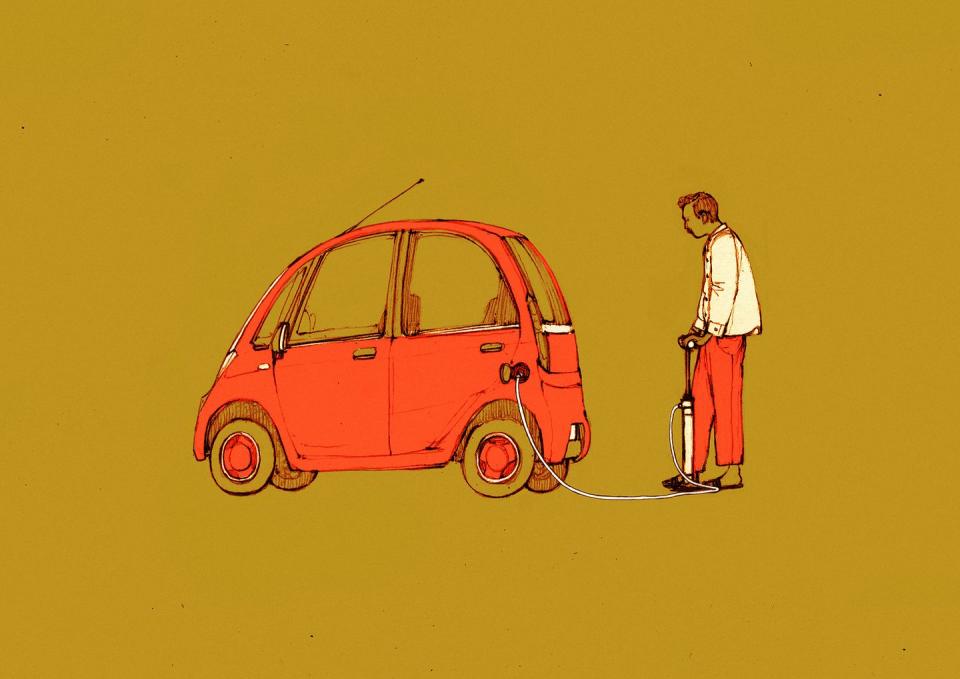The $2500 Car That Was Supposed to Run on Compressed Air


The provocative press release was still live in 2023, 16 years after its creation, on the Tata Motors corporate website. Dated February 5, 2007, and titled “An Engine Which Uses Air as Fuel,” the approximately 250-word announcement sketches a partnership between one of India’s largest automakers and the MDI Group, laying the groundwork for a potential revolution: “path-breaking technology for engines powered by air.”
This story originally appeared in Volume 21 of Road & Track.
At the time, Tata was hard at work developing a new hypereconomical gas-powered minicar that promised to move millions of Indian families from two wheels onto four. It was intended to split the price difference “between the cheapest car and the most expensive motorbike,” in the words of Ratan Tata, then group chairman. The planned Tata Nano would carry a target price of 100,000 rupees—about $2500 in 2008—and it grabbed the attention of the global motoring media.
Even more intriguing, Tata intended to bring its air engine to the all-new Nano, and quickly. For those paying attention, the ramifications were mind-boggling. Could the world’s cheapest and least-polluting vehicle soon become a reality in the second-most populous country on earth?
While enthusiasts in the U.S. and Europe stayed abreast of the Nano news from afar, the interest back home was “thermonuclear,” according to Evo India’s Sirish Chandran. In attendance at the Nano debut at Auto Expo 2008 in New Delhi, Chandran had no precedent for the bedlam surrounding the Nano reveal.
“Tata Motors had the largest stand at the expo, and yet there was no standing room,” says Chandran. “Journalists were standing in the pickup beds of other display cars. I’d never seen so many journalists at a launch event and, all these years later, have never seen as much interest in a new car.” Hundreds of thousands of Indians visited the expo that year, shattering records and portending huge things for the Nano’s commercial viability. “The whole country,” says Chandran, “whether interested in cars or not, was following the Nano story.”
A decade before the crowds coalesced in New Delhi, engineer and MDI founder Guy Negre was already deeply enmeshed in the technical challenge of moving a car with air power. A former engine developer for Formula 1, Negre began work on his air engine in 1997. By 2004, with a raft of patents under its belt, the MDI team was showing off working compressed-air car (CAC) prototypes. A CNN profile at the time showed vehicles that ranged from vanlike taxi configurations to small trucks, as well as an air-engine city car dubbed the MiniCAT. In the CNN report, Negre mused, “It is unthinkable to create an ecological car that is not also economical because people are not usually prepared to spend money to be environmentally friendly.”
Though the details of safely propelling a road car with a compressed-air engine are challenging, the basics are easy to understand. As pressurized air is released from a storage tank, it decompresses, pushing a piston, a driveshaft, and, eventually, a wheel. The process creates zero harmful emissions at the tailpipe, and the raw fuel is available anywhere humans draw breath.
Still, the technical hurdles of bringing an air engine to the public at scale were (and are) daunting. Using compressed air for propulsion creates two equally difficult problems with vehicle packaging. At higher psi, compressed air has more energy density and thus can provide more power and potential range to a passenger car. But storing highly pressurized air onboard necessitates incredibly strong tanks for safety. Making cars that are rolling bombs isn’t a good solution, obviously. Mass production would require a huge amount of cost to develop tanks robust enough to either never fail or fail safely.
Air doesn’t come precompressed either. Somewhere along the line—at some kind of station or depot or by way of an electrically powered onboard compressor—another kind of energy must be expended to create an air car’s fuel.
At the dawn of the current century, the technology around battery-electric vehicles (BEVs) was also far from commercially viable. A contemporary EV sold by India’s Reva Electric Car Company, for instance, offered less than 100 miles of range and cost roughly triple the price of the Nano. The idea of using a compressed-air engine, especially in a lightweight city car that didn’t need continent-crossing range, felt quite plausible. Particularly so with the backing of industrial partner Tata, which was looking to launch the most important vehicle in its history.
In July 2008, after the frenzy around all things Nano had calmed, the New York Times published a story with the headline “Designing Cars for Low-Carbon Chic.” The otherwise forgettable article broke a bit of news on the Tata and MDI technical partnership and quoted Negre as saying his air engine would “be offered as an option in Tata Motors’ new production model, the Nano, next year.” In the piece, Negre went on to say that the Nano would have a range of roughly 125 miles at a cost of about $3 to fill its air tanks (volume wasn’t specified). Those figures corresponded roughly with what Negre said MDI had achieved with earlier in-house prototypes, including the MiniCAT.
Yet, around the same time, Tata Motors was struggling mightily with the production of any kind of Nano at all. In 2006, the automaker announced that it would build a new factory in West Bengal, in the eastern part of India. However, construction of the plant faced huge opposition from local residents, including many farmers who were being displaced. In a nightmare for heavy-industry production logistics and the overall Nano rollout, the factory was relocated more than 1000 miles west to Gujarat. It’s fair to speculate that even if the air engine had been fully ready for production at this time, Tata management may have pushed it to the back of the queue.
Beyond the plant debacle, the first few years of the gas-powered Tata Nano were marred by controversy and bad press. First, there was the cost. While the company was able to hold the line on the famed 100,000-rupee sticker for early customers, rising material and production costs resulted in at least three price increases by 2010. Recalls in the first generation of the vehicle dimmed consumer enthusiasm for the Nano, as did a few very widely reported car fires of disparate origin. Sales of the Nano never tracked with the six-figure annual estimates Tata Motors envisioned at the start.
Even under better conditions, it’s unlikely that a Nano compressed-air car would have been viable. In 2009, a group of researchers from the University of California, Berkeley, and Stanford University authored a paper evaluating compressed-air-powered cars from economic and environmental viewpoints. The findings weren’t encouraging. The scientists built a model comparing gasoline-powered combustion-engine cars, BEVs, and theoretical air-engine vehicles, using factors such as thermodynamic efficiency, range performance, greenhouse gas (GHG) emissions, and cost to the consumer.

A car-lover’s community for ultimate access & unrivaled experiences.JOIN NOW Hearst Owned
While the researchers found some promise in using compressed-air power as part of a hybrid system with an internal-combustion engine (an idea into which other manufacturers have poured research dollars), the ultimate conclusion was pretty dire. Electric vehicles beat air cars like a drum. Even under “very optimistic assumptions about performance,” reads the report, “the CAC fared worse than the BEV in primary energy required, GHG emissions, and life-cycle costs.”
Journalist Chandran was able to intuit this on a visit to an MDI facility in France in 2007, before the agreement with Tata was even signed. When asked whether the compressed-air technology was compelling at this stage, Chandran didn’t blink: “The air car was pure fantasy. Even when I saw the prototypes at the factory, it seemed fantastical.”
Today, the tantalizing press release appears to have finally been taken down, and there isn’t a whiff of air on the consumer-facing portal. Nor does the company seem enthusiastic about discussing the project, leaving my emails and calls unreturned. MDI has been strangely reluctant to talk too. Considering the damning research and the radio silence, it’s possible that the “path-breaking” air car was only ever capable of breaking one thing: a promise to the public.
You Might Also Like

 Yahoo Finance
Yahoo Finance 